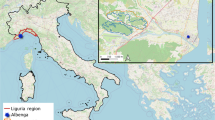Abstract
Traditional models result in low efficiency and poor accuracy when simulating the spread of large-scale forest fires. We constructed an improved model that couples cellular automata with an existing forest fire model to ensure better time accuracy of forest fire spread. Our model considers the impact of time steps on simulation accuracy to provide an optimal time step value. The model was tested using a case study of forest fire spread at Daxing’an Mountain in May 2006. The results show that the optimal time step for the forest fire spread geographic cellular automata simulation algorithm is 1/8 of the time taken for cellular material to be completely combusted. When compared with real fire data from Landsat Thematic Mapper (TM) images, our model was found to have high temporal and spatial consistency, with a mean Kappa coefficient of 0.6352 and mean accuracy of 87.89%. This algorithm can be used to simulate and predict forest fire spread and is also reversible (i.e., it can identify fire source points).







Similar content being viewed by others
References
Albini FA (1979) Spot fire distance from burning trees: a predictive model. Intermountain forest and range experiment station, forest service, US Department of Agriculture
Anderson DH, Catchpole EA, De Mestre NJ et al (1982) Modelling the spread of grass fires. J Aust Math Soc 23(4):451–466
Collin A, Bernardin D, Sero-Guillaume O (2011) A physical-based cellular automaton model for forest-fire propagation. Combust Sci Technol 183(4):347–369
Croft P, Hunter JT, Reid N (2016) Forgotten fauna: habitat attributes of long-unburnt open forests and woodlands dictate a rethink of fire management theory and practice. For Ecol Manage 366:166–174
Cunbin L, Jing Z, Baoguo T et al (2014) Analysis of forest fire spread trend surrounding transmission line based on rothermel model and huygens principle. Int J Multimedia Ubiquitous Eng 9(9):51–60
D’ambrogio A, Gaudio P, Gelfusa M et al (2016) Use of integrated technologies for fire monitoring and first alert. In: Proceedings of the 2016 IEEE 10th international conference on application of information and communication technologies (AICT)[C]. IEEE Press, New York, pp 1–5
Ding Z, Song K, Wang Z et al (2014) Contrastive analysis of algorithms of forest fire spreading simulation based on ArcGIS engine. J Univ Chin Acad Sci 31(5):640–646 (in Chinese)
Duff TJ, Chong DM, Tolhurst KG (2015) Using discrete event simulation cellular automata models to determine multi-mode travel times and routes of terrestrial suppression resources to wildland fires. Eur J Oper Res 241(3):763–770
Finney MA, Cohen JD, Mcallister SS et al (2013) On the need for a theory of wildland fire spread. Int J Wildl Fire 22(1):25–36
Fons WL (1946) Analysis of fire spread in hght forest fuels. J Agric Res 72(3):93–121
Gisborne HT (1927) The objectives of forest fire-weather research. J Forest 25(4):452–456
Hawley LF (1926) Theoretical considerations regarding factors which influence forest fires. J Forest 24(7):756–763
Kanga S, Singh SK (2017) Forest fire simulation modeling using remote sensing & GIS. Int J Adv Res Comput Sci 8(5):326–332
Li D, Wang C, Hu Y et al (2012) General review on remote sensing-based biomass estimation. Geom Inf Sci Wuhan Univ 37(6):631–635 (in Chinese)
Li F, Liu H, Zhang X et al (2013) Determination of spontaneous combusion extent in coal seams on the basis of the fractal theory. Coal Geol Explor 41(3):15–17 (in Chinese)
Mao X (1993) The influence of wind and relief on the speed of the forest fire spreading. Q J Appl Meteorol 4(1):100–104 (in Chinese)
Mcarthur AG (1966) Weather and grassland fire behaviour. Forestry and timber bureau, Department of National Development, Commonwealth of Australia
Papadopoulos GD, Pavlidou F-N (2011) A comparative review on wildfire simulators. Syst J IEEE 5(2):233–243
Rothermel RC (1972) A mathematical model for predicting fire spread in wildland fuels. USFS
Stocks BJ, Lynham T, Lawson B et al (1989) Canadian forest fire danger rating system: an overview. For Chron 65(4):258–265
Sullivan AL (2009) Wildland surface fire spread modelling, 1990–2007. 3: simulation and mathematical analogue models. Int J Wildl Fire 18(4):387–403
Wagner CV (1993) Prediction of crown fire behavior in two stands of jack pine. Can J For Res 23(3):442–449
Wang Z (1992) Current forest fire danger rating system. J Nat Disasters 1(3):39–44 (in Chinese)
Wang H, Zhang W, Chen Y et al (2011) Fire spreading model based on CA scope. Geom Inf Sci Wuhan Univ 36(5):575–578 (in Chinese)
Xia Q, Li G, Yin J (2009) Application of percolation theory in forest fire simulation. J Zhejiang For Coll 26(2):233–238 (in Chinese)
Zhan J, Fan C, Li T (2012) A forest firespot automatic detection algorithm for HJ-IRS imagery. Geom Inf Sci Wuhan Univ 37(11):1321–1324 (in Chinese)
Acknowledgements
This study was supported by the National Key Research and Development Program (Grant No: 2017YFB0503600) the National Natural Science Foundation of China (Grant No. 41771478), the Beijing Natural Science Foundation (Grant No. 8172046), and the Hebei Province Natural Science Fund (Grant No. D2016210008).
Author information
Authors and Affiliations
Corresponding author
Rights and permissions
About this article
Cite this article
Rui, X., Hui, S., Yu, X. et al. Forest fire spread simulation algorithm based on cellular automata. Nat Hazards 91, 309–319 (2018). https://doi.org/10.1007/s11069-017-3127-5
Received:
Accepted:
Published:
Issue Date:
DOI: https://doi.org/10.1007/s11069-017-3127-5




